Stress–Strain Curve and Carbonation Resistance of Recycled Aggregate Concrete after Using Different RCA Treatment Techniques
Abstract
1. Introduction
2. Materials and Experimental Program
2.1. Materials
2.2. Different RCA Treatment Techniques
2.2.1. Flow-Through Carbonation
2.2.2. Pressurized Carbonation
2.2.3. Wet Carbonation
2.2.4. NS Pre-Spraying
2.2.5. Combined Pressurized Carbonation with NS Pre-Spraying
2.3. New Concrete Mix Proportions
2.4. Testing Methods
2.4.1. Measurement of Water Absorption and Particle Density of RCA
2.4.2. Measurement of Density of Hardened Concrete
2.4.3. Measurement of Stress–Strain Curve of Concrete
2.4.4. Measurement of Carbonation Resistance of Concrete
3. Results and Discussion
3.1. Water Absorption and Particle Density of RCA
3.2. Density of Hardened Concrete
3.3. Stress–Strain Curve of Concrete
3.3.1. Peak Stress
3.3.2. Elastic Modulus
3.3.3. Peak Strain
3.3.4. Ultimate Strain
3.3.5. Toughness
3.3.6. Theoretical Model of Stress–Strain Curve
3.4. Carbonation Resistance of Concrete
4. Conclusions
- (1)
- The theoretical model for stress–strain curve of natural aggregate concrete was also suitable to RAC after subjecting to the RCA treatment techniques. For all the studied RCA treatment techniques, the peak stress and elastic modulus of RAC were enhanced, but the peak strain did not show significantly changes while the ultimate strain exhibited some reduction.
- (2)
- The 7-day carbonation depths of RAC after using flow-through carbonation, pressurized carbonation and combined pressurized carbonation with NS pre-spraying were larger than that of RAC using untreated RCA because of the negative effect the carbonated RCA. However, the 28-day carbonation depth of RAC was reduced after using all the studied RCA treatment techniques. In other words, the carbonation resistance of RAC could be enhanced by using these techniques.
- (3)
- Comparing the efficiency of different RCA treatment techniques in enhancement of the peak stress and elastic modulus, the combined pressurized carbonation with NS pre-spraying was the best because both the RA and the new ITZ between RA and the new mortar was enhanced, followed by NS pre-spraying, pressurized carbonation and flow-through carbonation, and the worst was the wet carbonation because only the surface layer of RA was carbonated. The combined pressurized carbonation with NS pre-spraying can significantly improve the performance of RAC, which was better than the other four techniques. Thus, this technique has potential to be used in practical applications.
Author Contributions
Funding
Institutional Review Board Statement
Informed Consent Statement
Acknowledgments
Conflicts of Interest
References
- Poon, C.S.; Shui, Z.H.; Lam, L. Effect of microstructure of ITZ on compressive strength of concrete prepared with recycled aggregates. Constr. Build. Mater. 2004, 18, 461–468. [Google Scholar] [CrossRef]
- Xuan, D.; Zhan, B.; Poon, C.S. Durability of recycled aggregate concrete prepared with carbonated recycled concrete aggregates. Cem. Concr. Compos. 2017, 84, 214–221. [Google Scholar] [CrossRef]
- Xuan, D.X.; Zhan, B.J.; Poon, C.S. Assessment of mechanical properties of concrete incorporating carbonated recycled concrete aggregates. Cem. Concr. Compos. 2016, 65, 67–74. [Google Scholar] [CrossRef]
- Li, L.; Xiao, J.; Xuan, D.X.; Poon, C.S. Effect of carbonation of modeled recycled coarse aggregate on the mechanical properties of modeled recycled aggregate concrete. Cem. Concr. Compos. 2018, 89, 169–180. [Google Scholar] [CrossRef]
- Xiao, J.Z.; Li, J.B.; Zhang, C. Mechanical properties of recycled aggregate concrete under uniaxial loading. Cem. Concr. Res. 2005, 35, 1187–1194. [Google Scholar] [CrossRef]
- Ryu, J.S. An experimental study on the effect of recycled aggregate on concrete properties. Mag. Concr. Res. 2002, 54, 7–12. [Google Scholar] [CrossRef]
- Topçu, I.B.; Sengel, S. Properties of concretes produced with waste concrete aggregate. Cem. Concr. Res. 2004, 34, 1307–1312. [Google Scholar] [CrossRef]
- Etxeberria, M.; Vázquez, E.; Marí, A.; Barra, M. Influence of amount of recycled coarse aggregates and production process on properties of recycled aggregate concrete. Cem. Concr. Res. 2007, 37, 735–742. [Google Scholar] [CrossRef]
- Xuan, D.; Molenaar, A.A.A.; Houben, L.J.M. Compressive and indirect tensile strengths of cement-treated mix granulates with recycled masonry and concrete aggregates. J. Mater. Civ. Eng. 2012, 24, 577–585. [Google Scholar] [CrossRef]
- Ke, X.; Xu, D.; Cai, M. Experimental and numerical study on the eccentric compressive performance of RAC-encased RACFST composite columns. Eng. Struct. 2020, 224, 111227. [Google Scholar] [CrossRef]
- Quattrone, M.; Angulo, S.C.; John, V.M. Energy and CO2 from high performance recycled aggregate production. Resour. Conserv. Recycl. 2014, 90, 21–33. [Google Scholar] [CrossRef]
- Nagataki, S.; Gokce, A.; Saeki, T.; Hisada, M. Assessment of recycling process induced damage sensitivity of recycled concrete aggregates. Cem. Concr. Res. 2004, 34, 965–971. [Google Scholar] [CrossRef]
- Bru, K.; Touze, S.; Bourgeois, F.; Lippiatt, N.; Menard, Y. Assessment of a microwave-assisted recycling process for the recovery of high-quality aggregates from concrete waste. Int. J. Miner. Process. 2014, 126, 90–98. [Google Scholar] [CrossRef]
- Akbarnezhad, A.; Ong, K.C.G.; Zhang, M.H.; Tam, C.T.; Foo, T.W.J. Microwave assisted beneficiation of recycled concrete aggregates. Constr. Build. Mater. 2011, 25, 3469–3479. [Google Scholar] [CrossRef]
- Katz, A. Treatments for the improvement of recycled aggregate. J. Mater. Civ. Eng. 2004, 16, 597–603. [Google Scholar] [CrossRef]
- Tam, V.W.Y.; Tam, C.M.; Le, K.N. Removal of cement mortar remains from recycled aggregate using pre-soaking approaches. Resour. Conserv. Recycl. 2007, 50, 82–101. [Google Scholar] [CrossRef]
- Zhan, B.J.; Poon, C.S.; Liu, Q.; Kou, S.C.; Shi, C.J. Experimental study on CO2 curing for enhancement of recycled aggregate properties. Constr. Build. Mater. 2014, 67, 3–7. [Google Scholar] [CrossRef]
- Kou, S.C.; Zhan, B.J.; Poon, C.S. Use of a CO2 curing step to improve the properties of concrete prepared with recycled aggregates. Cem. Concr. Compos. 2014, 45, 22–28. [Google Scholar] [CrossRef]
- Li, L.; Poon, C.S.; Xiao, J.; Xuan, D.X. Effect of carbonated recycled coarse aggregate on the dynamic compressive behavior of recycled aggregate concrete. Constr. Build. Mater. 2017, 151, 52–62. [Google Scholar] [CrossRef]
- Zhang, J.K.; Shi, C.J.; Li, Y.K.; Pan, X.Y.; Poon, C.S. Performance enhancement of recycled concrete aggregates through carbonation. J. Mater. Civ. Eng. 2015, 27, 04015029. [Google Scholar] [CrossRef]
- Grabiec, A.M.; Klama, J.; Zawal, D.; Krupa, D. Modification of recycled concrete aggregate by calcium carbonate bio deposition. Constr. Build. Mater. 2012, 34, 145–150. [Google Scholar] [CrossRef]
- Cheng, H.L.; Wang, C.Y. The influence of sodium silicate on the properties of recycled aggregate. Gypsum Cem. Build. 2005, 12, 12–14. [Google Scholar]
- Kou, S.C.; Poon, C.S. Properties of concrete prepared with PVA-impregnated recycled concrete aggregates. Cem. Concr. Compos. 2010, 32, 649–654. [Google Scholar] [CrossRef]
- Mansur, A.; Santos, D.; Mansur, H. A microstructural approach to adherence mechanism of poly (vinyl alcohol) modified cement systems to ceramic tiles. Cem. Concr. Res. 2007, 37, 270–282. [Google Scholar] [CrossRef]
- Tam, V.W.Y.; Gao, X.F.; Tam, C.M. Microstructural analysis of recycled aggregate concrete produced from two-stage mixing approach. Cem. Concr. Res. 2005, 35, 1195–1203. [Google Scholar] [CrossRef]
- Li, J.; Xiao, H.; Zhou, Y. Influence of coating recycled aggregate surface with pozzolanic powder on properties of recycled aggregate concrete. Constr. Build. Mater. 2009, 23, 1287–1291. [Google Scholar] [CrossRef]
- Zhang, H.; Zhao, Y.; Meng, T.; Shah, S.P. Surface treatment on recycled coarse aggregates with nanomaterials. J. Mater. Civ. Eng. 2015, 28, 04015094. [Google Scholar] [CrossRef]
- Zeng, W.; Zhao, Y.; Zheng, H.; Poon, C.S. Improvement in corrosion resistance of recycled aggregate concrete by nano silica suspension modification on recycled aggregates. Cem. Concr. Compos. 2020, 106, 103476. [Google Scholar] [CrossRef]
- Liang, C.; Pan, B.; Ma, Z.; He, Z.; Duan, Z. Utilization of CO2 curing to enhance the properties of recycled aggregate and prepared concrete: A review. Cem. Concr. Compos. 2020, 105, 103446. [Google Scholar] [CrossRef]
- Shi, C.J.; Wu, Z.M.; Cao, Z.J.; Ling, T.C.; Zheng, J.L. Performance of mortar prepared with recycled concrete aggregate enhanced by CO2 and pozzolan slurry. Cem. Concr. Compos. 2018, 86, 130–138. [Google Scholar] [CrossRef]
- Kashef-Haghighi, S.; Ghoshal, S. CO2 sequestration in concrete through accelerated carbonation curing in a flow-through reactor. Ind. Eng. Chem. Res. 2009, 49, 1143–1149. [Google Scholar] [CrossRef]
- Maciej, Z.; Jørgen, S.; Jan, S.; Pawel, D.; Frank, B.; Mohsen, B.H. Phase assemblage and microstructure of cement paste subjected to enforced, wet carbonation. Cem. Concr. Res. 2020, 130, 105990. [Google Scholar]
- Bertos, M.F.; Simons, S.J.R.; Hills, C.D.; Carey, P.J. A review of accelerated carbonation technology in the treatment of cement-based materials and sequestration of CO2. J. Hazard Mater. 2004, 112, 193–205. [Google Scholar]
- Faiz, S.; Vimal, C.; Naji, M. Effect of mixing methods of nano silica on properties of recycled aggregate concrete. Struct. Concr. 2018, 19, 387–399. [Google Scholar]
- Li, L.; Xuan, D.X.; Sojobi, A.O.; Liu, S.; Chu, S.H.; Poon, C.S. Development of nano-silica treatment methods to enhance recycled aggregate concrete. Cem. Concr. Compos. 2021, 118, 103963. [Google Scholar] [CrossRef]
- Kazmi, S.M.S.; Munir, M.J.; Wu, Y.F.; Patnaikuni, I.; Zhou, Y.; Xing, F. Influence of different treatment methods on the mechanical behavior of recycled aggregate concrete: A comparative study. Cem. Concr. Compos. 2019, 104, 103398. [Google Scholar] [CrossRef]
- Zhan, B.J.; Xuan, D.X.; Poon, C.S.; Scrivener, K.L. Characterization of interfacial transition zone in concrete prepared with carbonated modeled recycled concrete aggregates. Cem. Concr. Res. 2020, 136, 106175. [Google Scholar] [CrossRef]
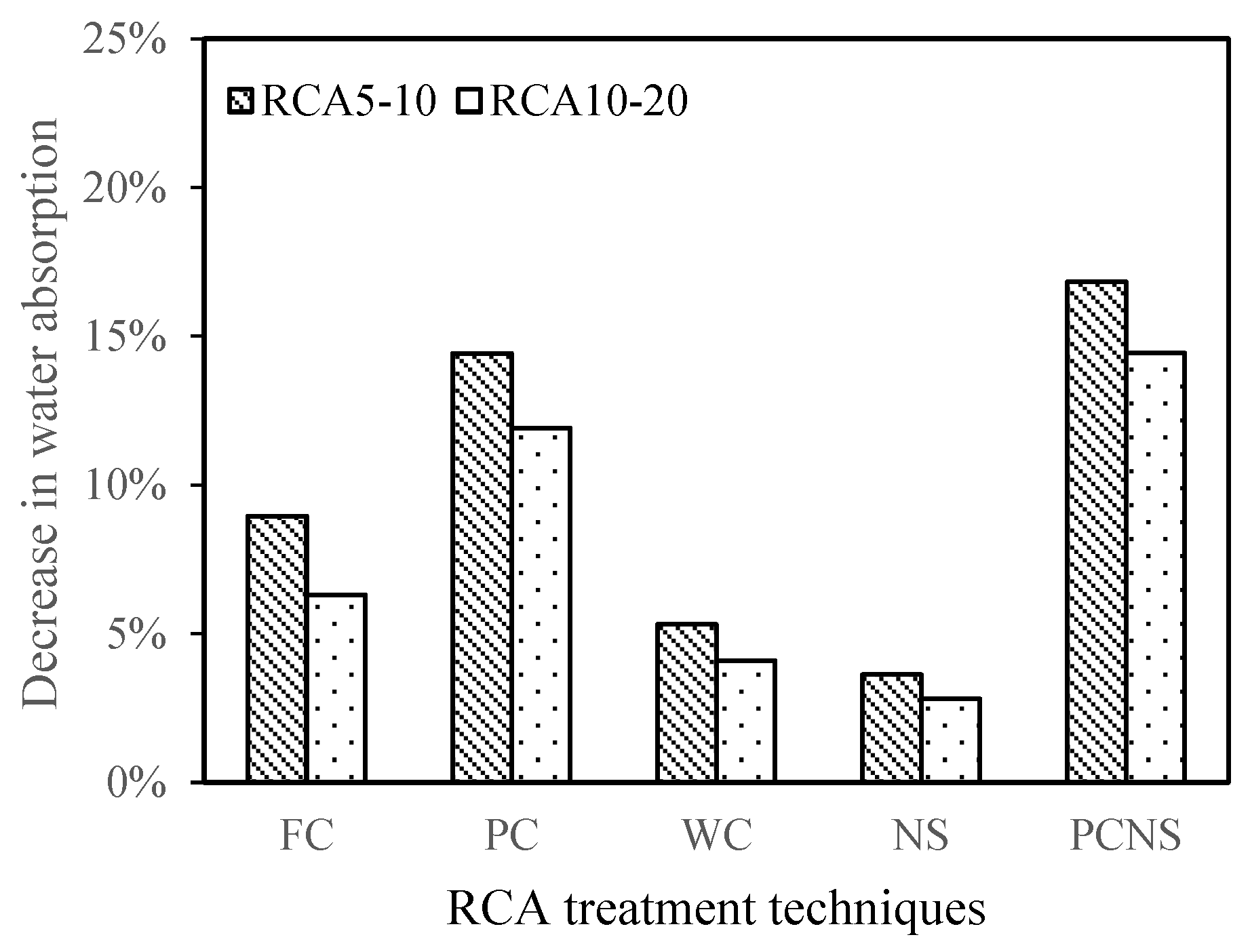


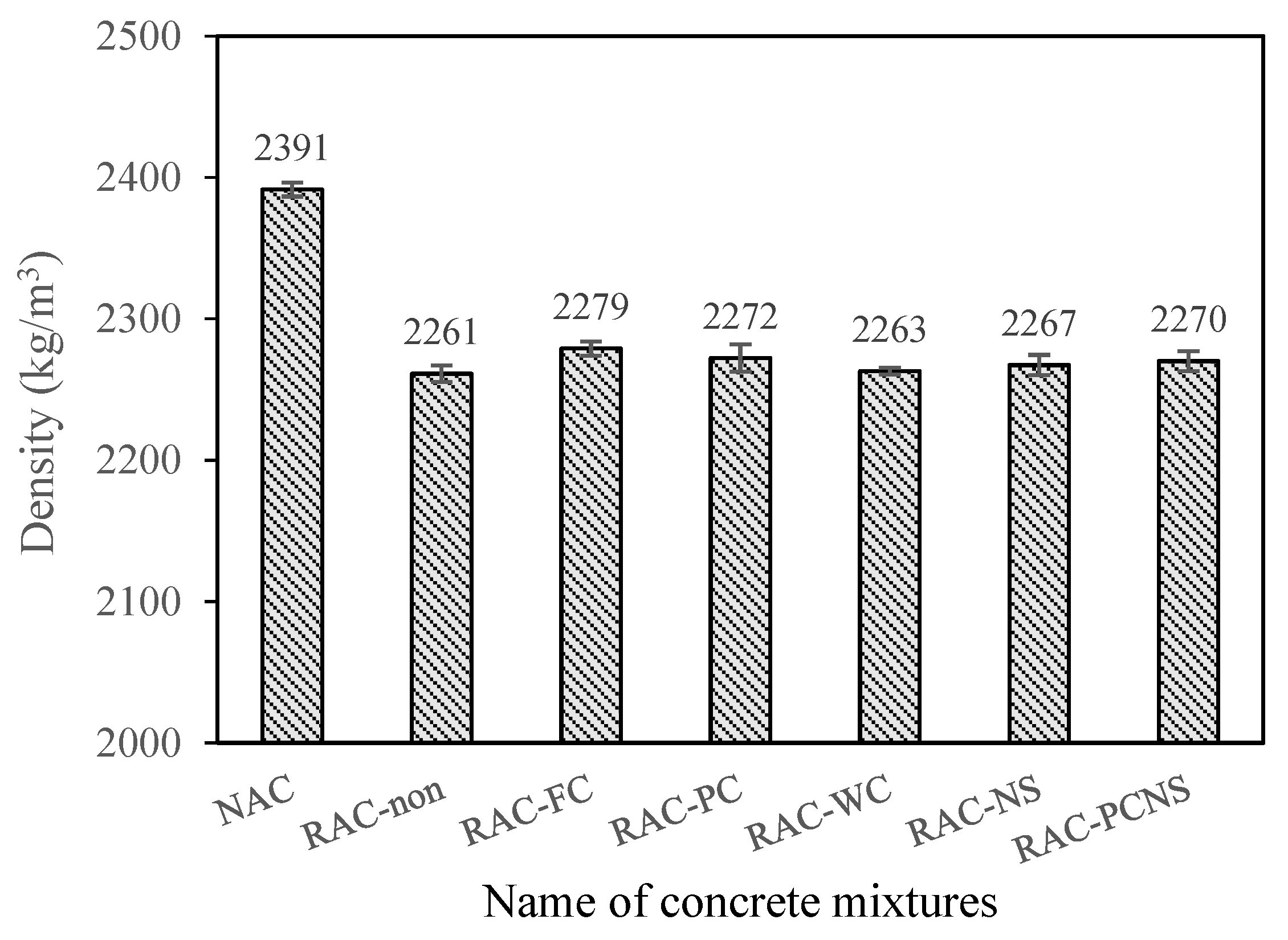
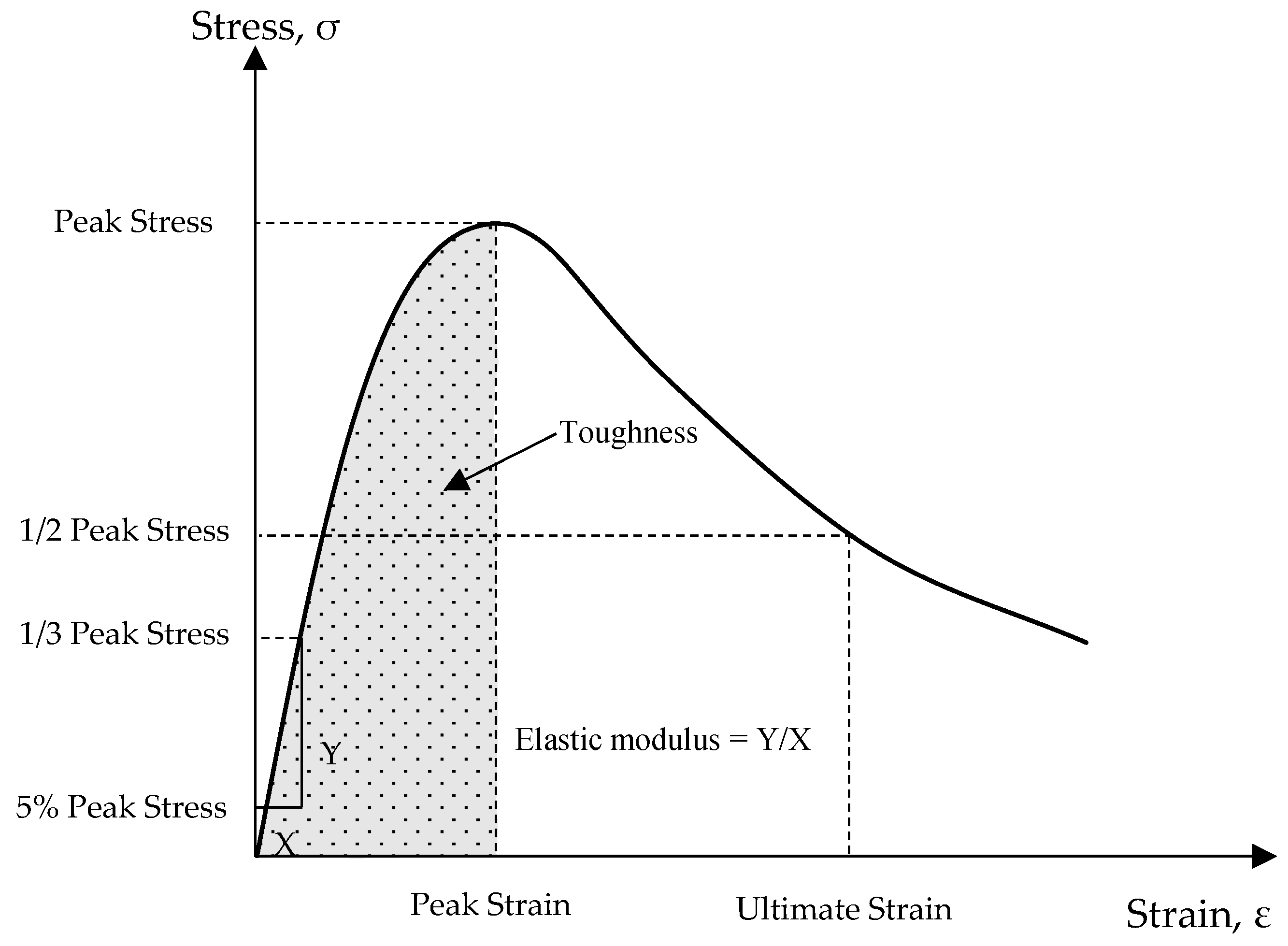
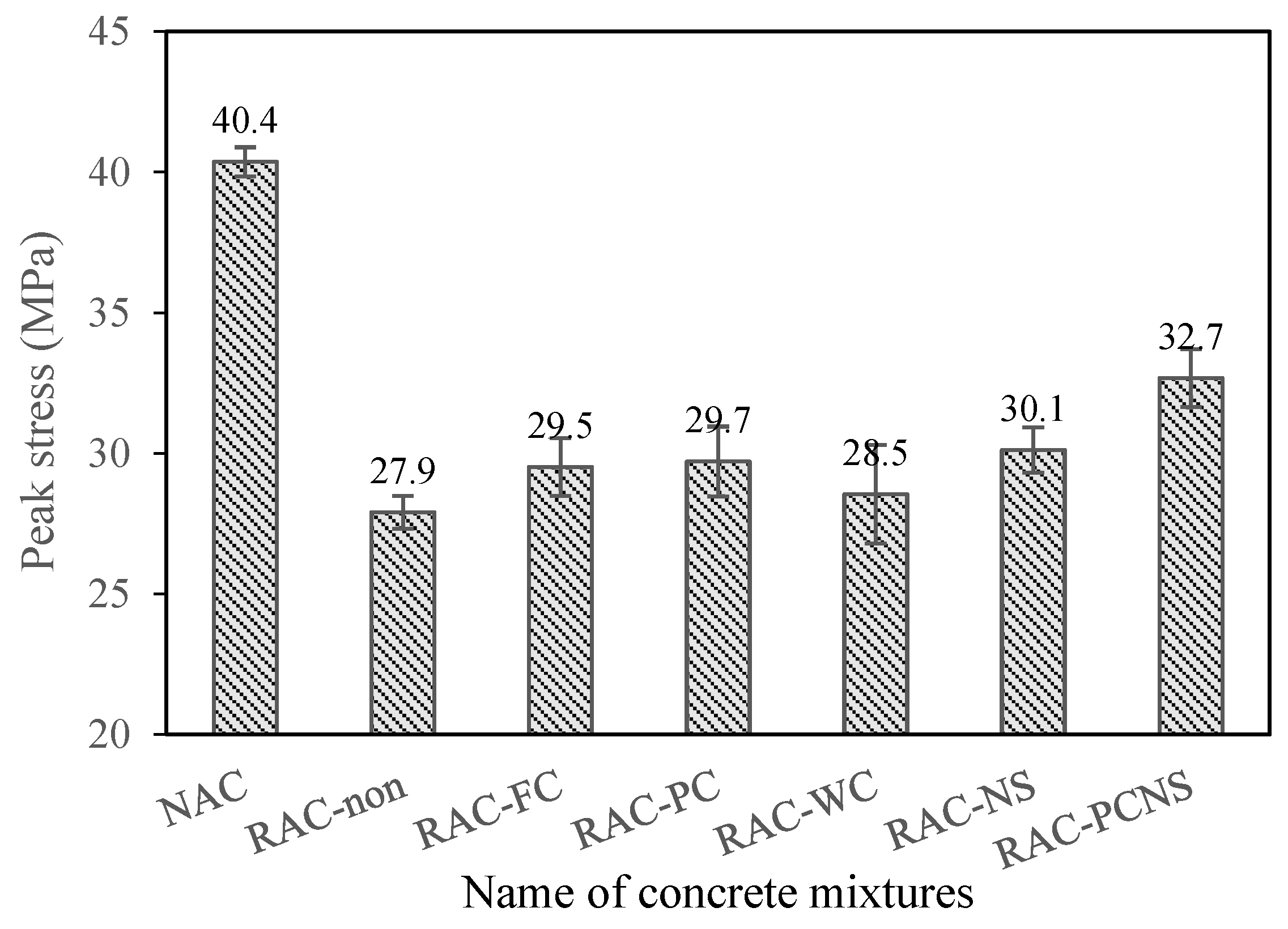
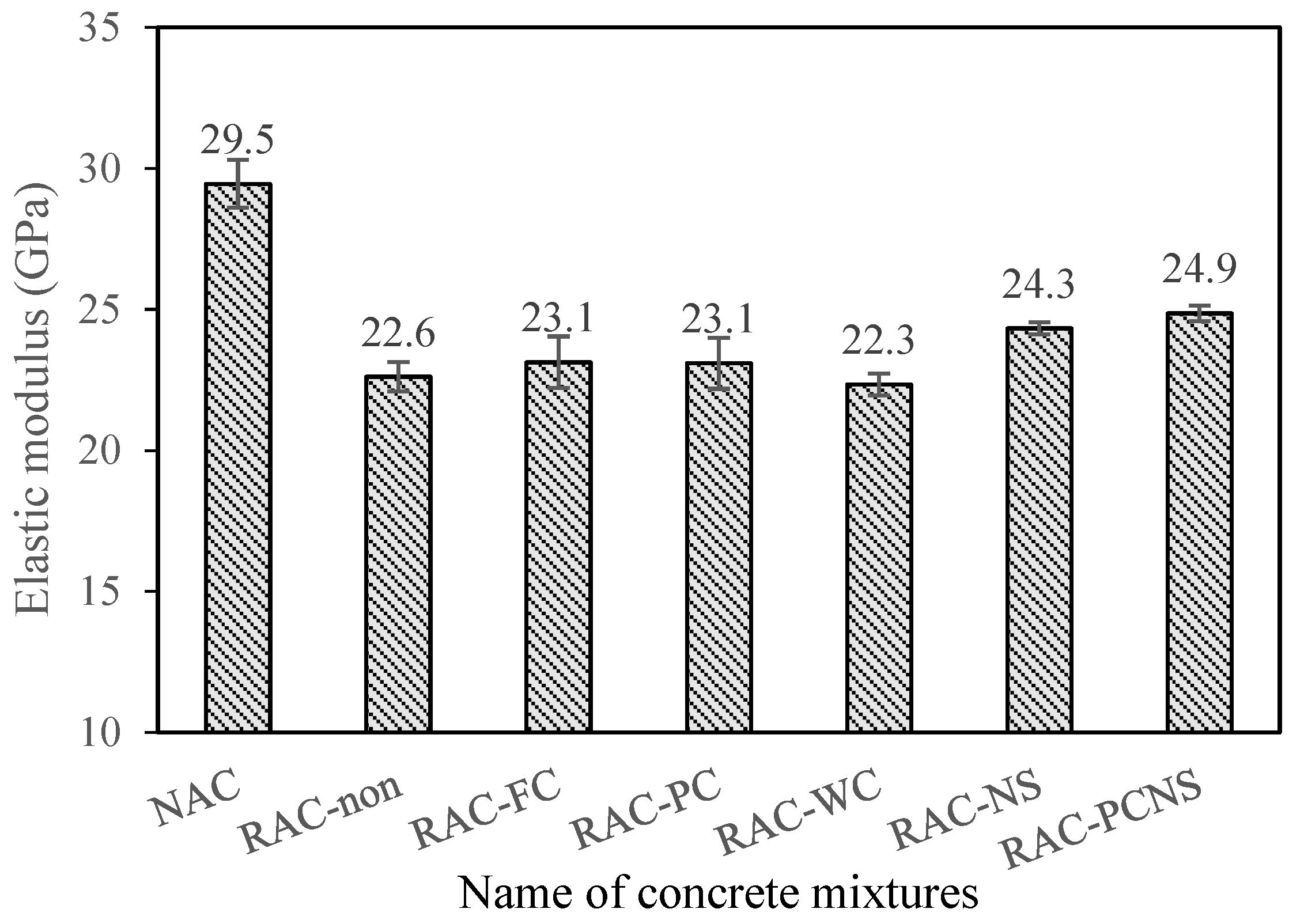

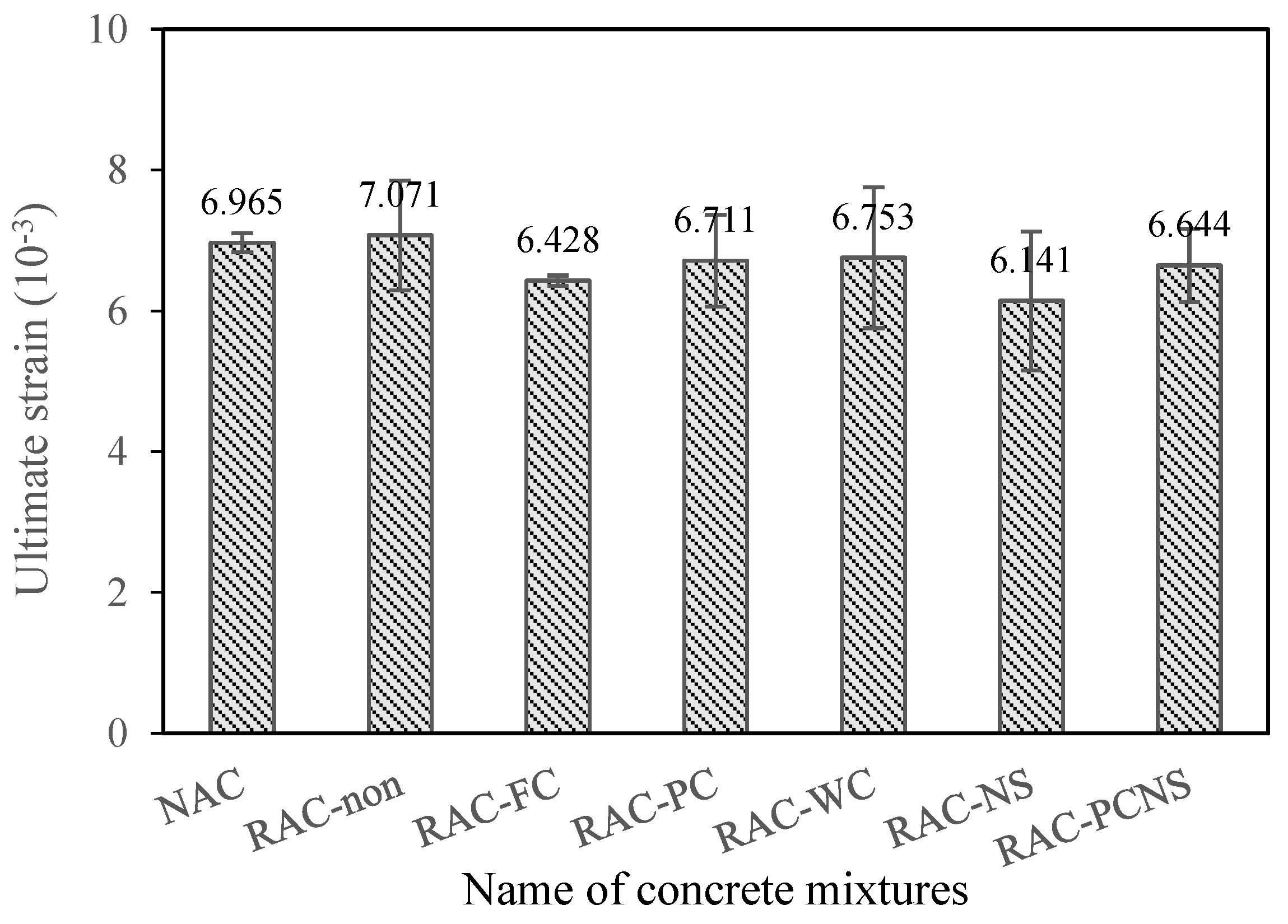
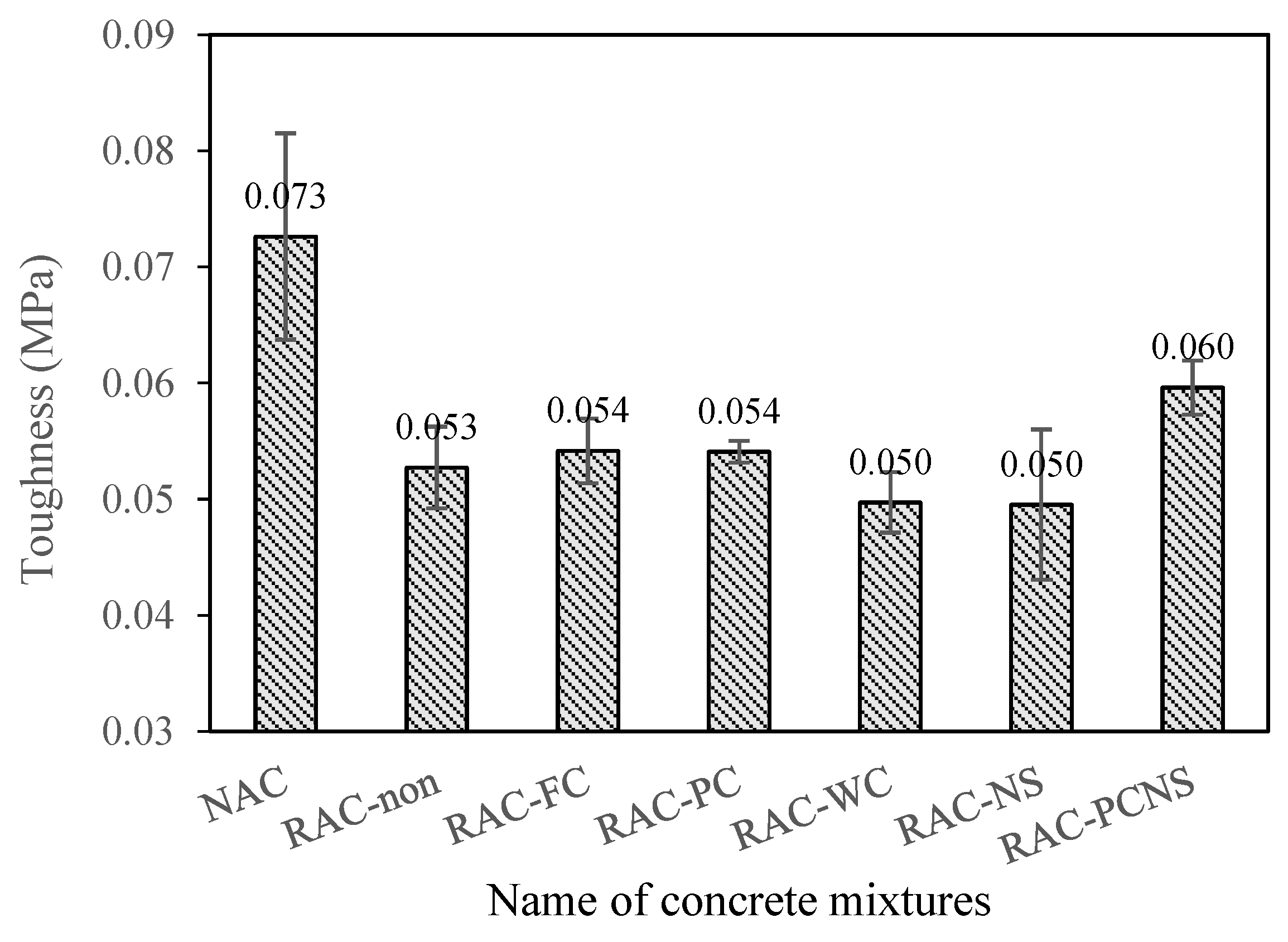
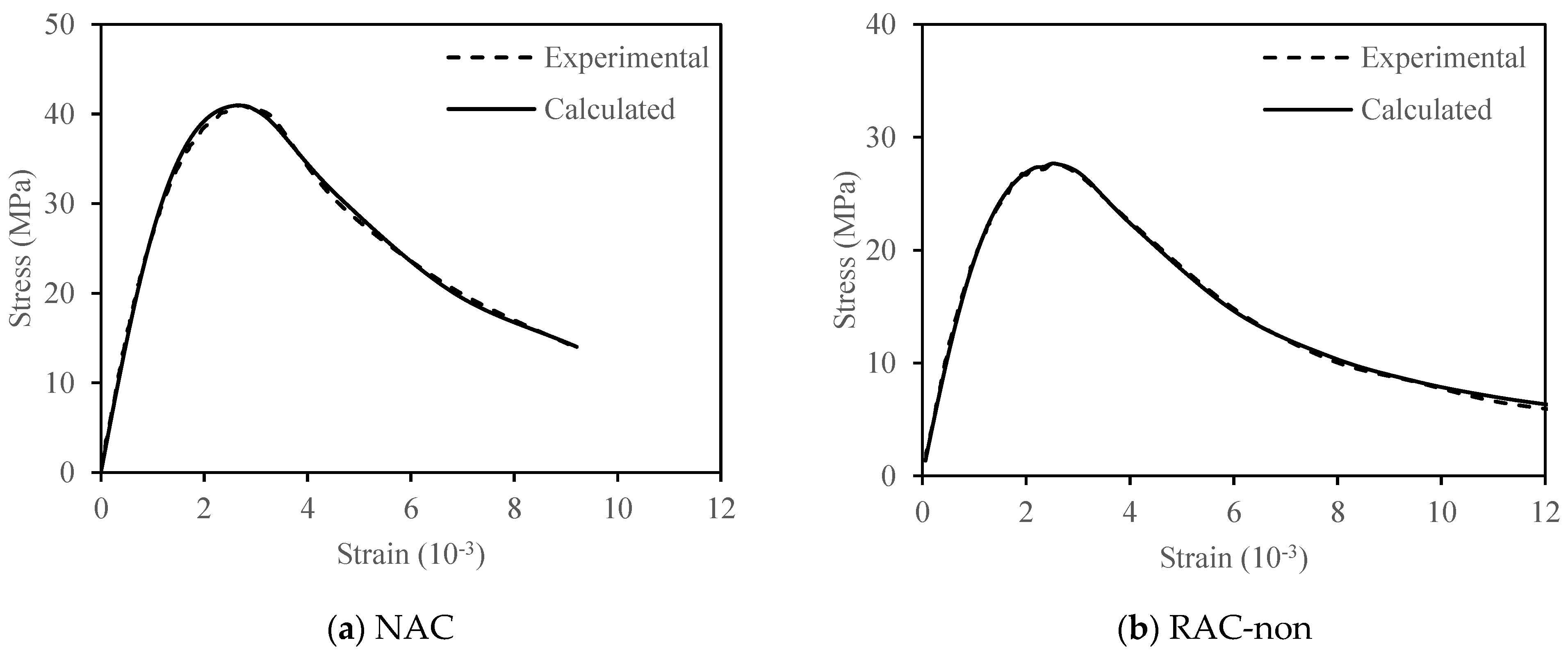
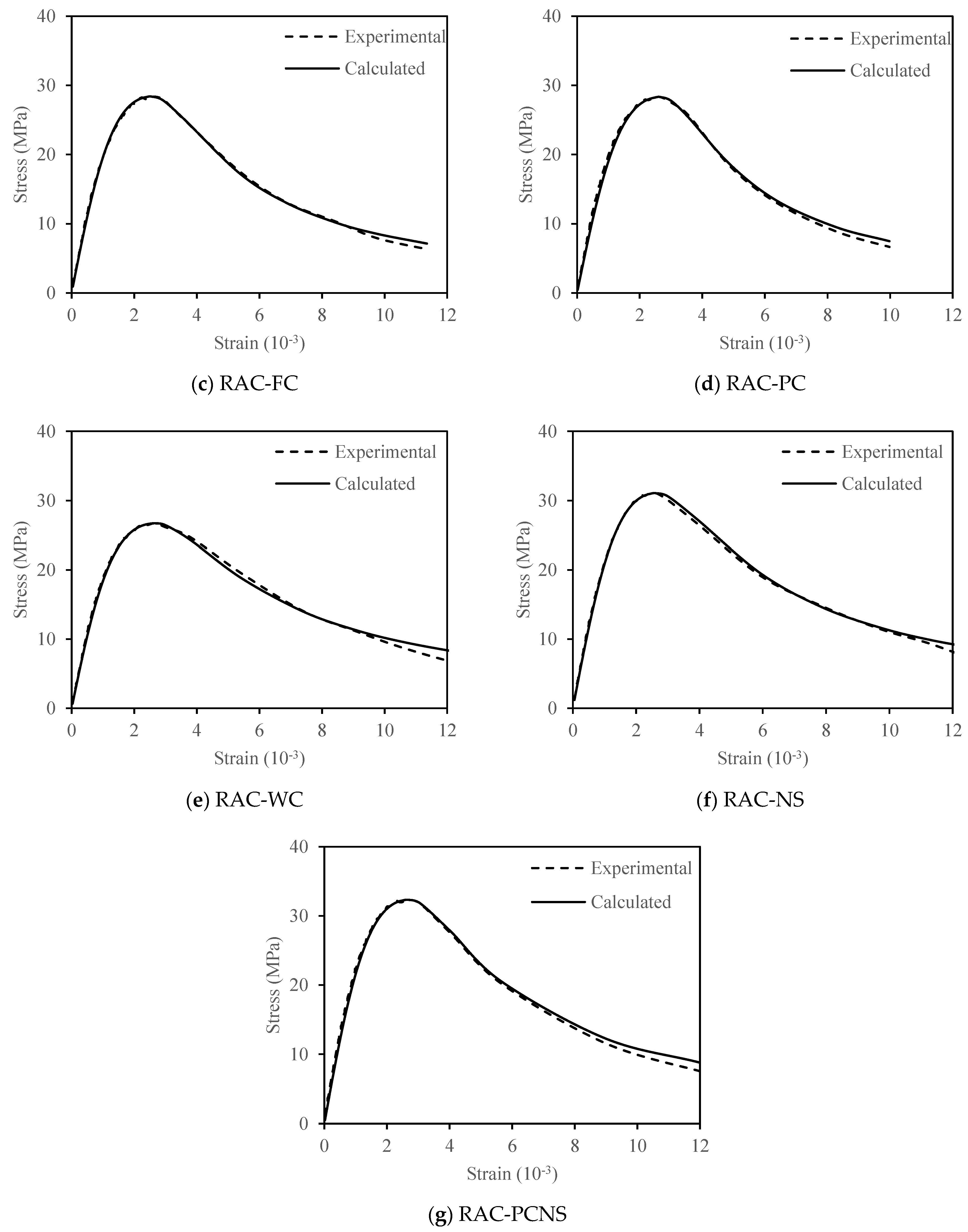
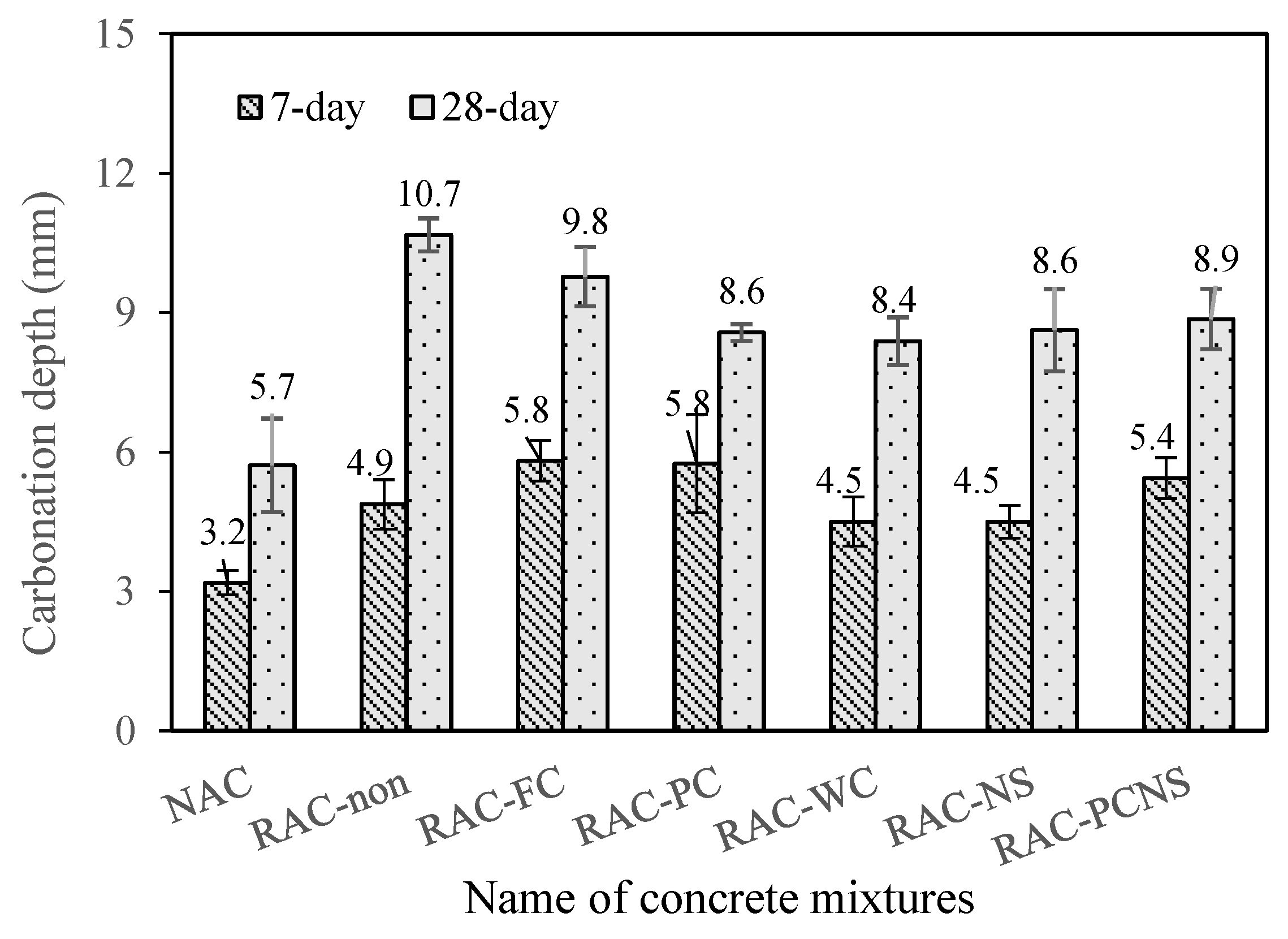
| Aggregate | Size (mm) | Water Absorption (%) | Particle Density (kg/m3) |
|---|---|---|---|
| RCA5–10 | 5–10 | 6.72% | 2229 |
| RCA10–20 | 10–20 | 7.77% | 2196 |
| NCA5–10 | 5–10 | 0.69% | 2634 |
| NCA10–20 | 10–20 | 0.57% | 2602 |
| W/C Ratio | Water | Cement | Sand | Coarse Aggregate (5–10 mm) | Coarse Aggregate (10–20 mm) |
|---|---|---|---|---|---|
| 0.60 | 195 | 325 | 752 | 282 | 846 |
Publisher’s Note: MDPI stays neutral with regard to jurisdictional claims in published maps and institutional affiliations. |
© 2021 by the authors. Licensee MDPI, Basel, Switzerland. This article is an open access article distributed under the terms and conditions of the Creative Commons Attribution (CC BY) license (https://creativecommons.org/licenses/by/4.0/).
Share and Cite
Li, L.; Xuan, D.; Poon, C.S. Stress–Strain Curve and Carbonation Resistance of Recycled Aggregate Concrete after Using Different RCA Treatment Techniques. Appl. Sci. 2021, 11, 4283. https://doi.org/10.3390/app11094283
Li L, Xuan D, Poon CS. Stress–Strain Curve and Carbonation Resistance of Recycled Aggregate Concrete after Using Different RCA Treatment Techniques. Applied Sciences. 2021; 11(9):4283. https://doi.org/10.3390/app11094283
Chicago/Turabian StyleLi, Long, Dongxing Xuan, and Chi Sun Poon. 2021. "Stress–Strain Curve and Carbonation Resistance of Recycled Aggregate Concrete after Using Different RCA Treatment Techniques" Applied Sciences 11, no. 9: 4283. https://doi.org/10.3390/app11094283
APA StyleLi, L., Xuan, D., & Poon, C. S. (2021). Stress–Strain Curve and Carbonation Resistance of Recycled Aggregate Concrete after Using Different RCA Treatment Techniques. Applied Sciences, 11(9), 4283. https://doi.org/10.3390/app11094283







